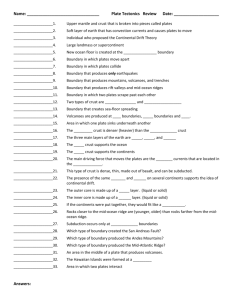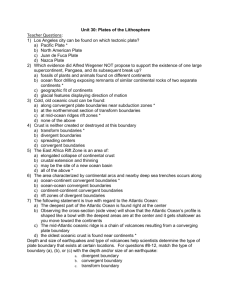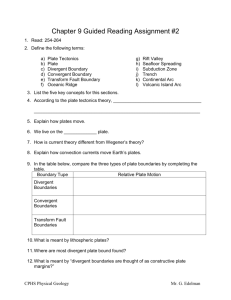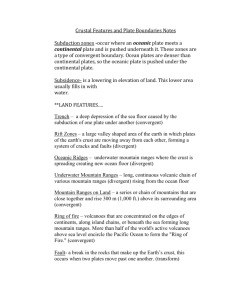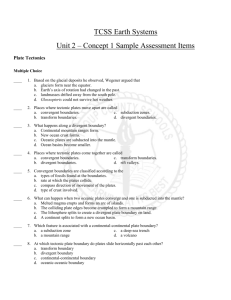Plate Tectonics Test: High School Geology
advertisement
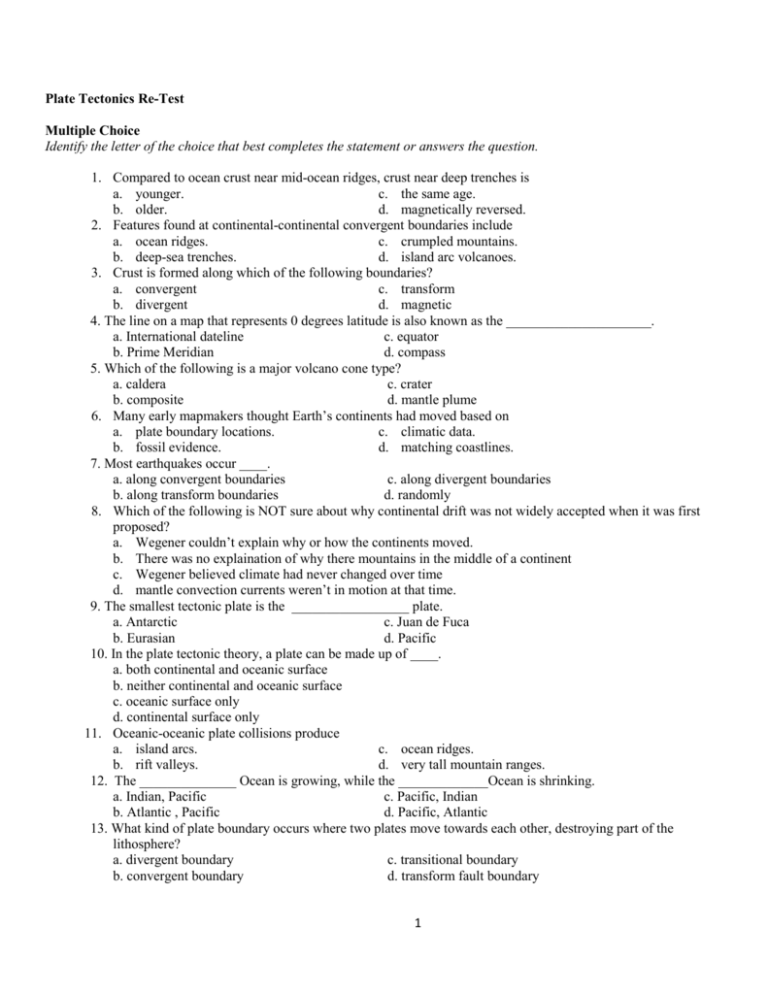
Plate Tectonics Re-Test Multiple Choice Identify the letter of the choice that best completes the statement or answers the question. 1. Compared to ocean crust near mid-ocean ridges, crust near deep trenches is a. younger. c. the same age. b. older. d. magnetically reversed. 2. Features found at continental-continental convergent boundaries include a. ocean ridges. c. crumpled mountains. b. deep-sea trenches. d. island arc volcanoes. 3. Crust is formed along which of the following boundaries? a. convergent c. transform b. divergent d. magnetic 4. The line on a map that represents 0 degrees latitude is also known as the _____________________. a. International dateline c. equator b. Prime Meridian d. compass 5. Which of the following is a major volcano cone type? a. caldera c. crater b. composite d. mantle plume 6. Many early mapmakers thought Earth’s continents had moved based on a. plate boundary locations. c. climatic data. b. fossil evidence. d. matching coastlines. 7. Most earthquakes occur ____. a. along convergent boundaries c. along divergent boundaries b. along transform boundaries d. randomly 8. Which of the following is NOT sure about why continental drift was not widely accepted when it was first proposed? a. Wegener couldn’t explain why or how the continents moved. b. There was no explaination of why there mountains in the middle of a continent c. Wegener believed climate had never changed over time d. mantle convection currents weren’t in motion at that time. 9. The smallest tectonic plate is the _________________ plate. a. Antarctic c. Juan de Fuca b. Eurasian d. Pacific 10. In the plate tectonic theory, a plate can be made up of ____. a. both continental and oceanic surface b. neither continental and oceanic surface c. oceanic surface only d. continental surface only 11. Oceanic-oceanic plate collisions produce a. island arcs. c. ocean ridges. b. rift valleys. d. very tall mountain ranges. 12. The ______________ Ocean is growing, while the _____________Ocean is shrinking. a. Indian, Pacific c. Pacific, Indian b. Atlantic , Pacific d. Pacific, Atlantic 13. What kind of plate boundary occurs where two plates move towards each other, destroying part of the lithosphere? a. divergent boundary c. transitional boundary b. convergent boundary d. transform fault boundary 1 14. Sea-floor spreading results in the formation of a. a deep-sea trench. c. a rift valley. b. new oceanic crust. d. new continental crust. 15. What type of boundary occurs where two plates move apart? a. transform fault boundary c. convergent boundary b. divergent boundary d. transitional boundary 16. One kind of evidence that does NOT support Wegener’s hypothesis is that ____. a. climate has not changed over time b. major rivers on different continents match c. mountains and coal fields on different continents line up d. fossils of the same organism have been found on different continents 17. Rift valleys are associated with ____. a. ocean ridge systems c. transform fault boundaries b. subduction zones d. divergent boundaries 18. What was the main reason Wegener’s continental drift hypothesis was rejected? a. He could provide only illogical explanations for the movement of the continents. b. His evidence was incorrect. c. He was not well liked by other scientists. d. He could not provide a mechanism for the movement of the continents. 19. Crust is destroyed at a _________________ boundary. a. Transform c. Divergent b. Convergent d. Personal 20. Tectonic plate motion is produce by a. convection currents c. rotation of the earth b. earthquakes d. fracture zones 21. This area is both a major earthquake zone and volcano zone. a. Pacific Ring of Volcanoes c. Pacific Ring of Fire b. Atlantic Ring of Fire d. Pacific Island Arc 22. The supercontinent in the continental drift hypothesis was called ____. a. Pandora c. Pangaea b. Pegasus d. Panthalassa 23. The driving forces of tectonic plates are related to convection currents in the Earth’s __________. a. crust c. inner core b. mantle d. outer core 24. A volcanic mountain range is evidence of what kind of plate boundary? a. convergent c. transform b. divergent d. uniform 25. A convergent boundary at two oceanic plates can result in a ____. a. rift valley c. continental volcanic arc b. volcanic island arc d. island arc 26. The mantle produces Earth’s a. gravity. c. convection currents. b. warmth. d. water 27. The oldest rocks on the ocean floor are typically located where? a. close to a mid-ocean ridge c. close to a deep-sea trench b. far from a mid-ocean ridge d. far from a deep-sea trench 28. The thinnest layer of the Earth is the __________________. a. inner core c. continental crust b. mantle d. outer core 2 29. Which of the following is a geographic example of a convergent boundary? a. the East African Rift valley c. the Mid-Atlantic Ridge b. the San Andreas Fault d. the Andes Mountains 30. Each cycle of spreading and intrusion of magma during seafloor spreading results in a. magnetic reversals. c. subduction. b. new ocean crust. d. plates colliding. 31. The outer core is made of __________ and ___________ metals, and it is in a _____________ state. a. iron, nickel, solid c. copper, gold, gaseous b. iron, nickel, liquid d. molten rock, iron, liquid 32. The scale that is commonly used to determine the intensity of an earthquake is called _______________. a. Sonar c. Radio b. Richter Scale d. Seismometer 33. What state did Ms. Allen teach in? a. Alabama c. California b. Alaska d. Conneticut Matching A B C D Match each letter that appears on the diagram with the appropriate feature below. 34. _____ Divergent plate boundary 35. _____ Convergent plate boundary 36. _____ Convection Current 37. _____ Slab-pull Match the term with the correct definition. a. Continental drift b. Plate tectonics c. Cinder-cone volcano d. Composite volcano e. Hot spot 38. Unusually hot area in Earth’s mantle that can melt through Earth’s crust 39. Large, sloping volcano built by violent eruptions of volcanic fragments and lava that accumulate in alternating layers 40. The hypothesis that Earth’s continents were joined as a single landmass 41. Steep-sided, generally small volcano that is built by the accumulation of ash around the vent 42. Theory that states that Earth’s crust is broken into plates 3 Completion Complete each sentence or statement. Use the list below to identify the term that best completes the statement. fossil Pangaea Ridge push Deep-ocean trenches 43. 44. 45. 46. 47. 48. 49. 50. 51. 52. mountains plates together Slab pull transform boundaries apart ____________________ is a process that occurs at convergent boundaries. Any trace of an ancient organism preserved in rock is called a(n) __________________. Wegener named his supercontinent ______________________. Earthquakes are a common result of __________________________. Convergent boundaries are places where plates move _____________. _______________ are the result of two continental plates colliding. ____________________ is a process whereby the weight of an uplifted ocean ridge pushes an oceanic plate toward a subduction zone. Deep underwater canyons are called _____________________. The theory of plate tectonics states that Earth’s crust and rigid upper mantle are broken into enormous slabs called _________________ that move slowly over Earth’s surface. Plates move _________________ at divergent boundaries Short Answer 53. Compare and contrast continental drift and the theory of plate tectonics. 54. Compare and contrast all three types of plate boundaries. Use the diagram on your answer sheet to answer the following questions:. 55. Where is the subduction zone? Mark its position on the diagram with the letter B. 56. Locate the convection currents and mark them with the letter E. 57. Where is the trench? Mark this area with the letter S. 58. Where is a divergent plate boundary? Mark this area with the letter T. 59. FREE POINTS! YAY FOR YOU! 60-63. Label all layers of the earth. 4


